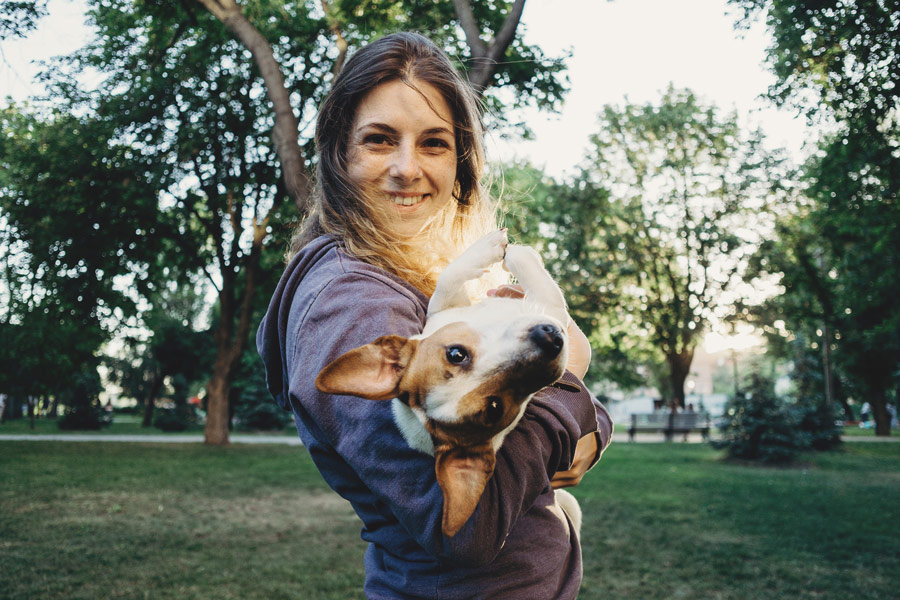Dogs are one of our favourite animal companions and our evolutionary histories are intertwined. Looking at our Pomeranian curled up at our feet, it might be hard to imagine that, at one point, dogs were fearsome predators, but current evidence suggests that the wolf (Canis lupus) is the primary wild ancestor of our present-day dog. Let’s take a closer look at the history behind one of our oldest animal companions.
Dogs evolved from a wolf-like ancestor about 15,000 years ago, around the time humans switched from a nomadic to an agricultural lifestyle. As people settled into permanent villages, dogs scavenged on their agricultural waste, gaining a regular supply of food while providing humans with waste disposal, pest control, and protection from predators. The genetically fittest animals – those with low fear and aggression to people, and who could digest human foods – gradually evolved from hunters to scavengers.

Animals with immature and inquisitive traits were typically tamer and safer around humans, so dogs with those traits were most successful at thriving in human communities. During domestication, dogs became neotenized, meaning their former social, emotional, and behavioural development was stunted. Along with permanent immaturity, they developed floppy ears, shorter muzzles, variation in coat colour, and the large eyes that we can’t help but love. This relationship between behavioural and physical traits has also been observed in a captive population of silver foxes. After a few generations of breeding the tamer individuals that were easiest to handle, the foxes developed floppy ears and curly tails. In the last 300 years, humans have further selected dogs with desirable behavioural and physical characteristics. Now, nearly 400 breeds of dog are recognised worldwide, with vast variation in size, shape, colour, and behaviour.
Throughout history, the original purpose of many breeds was to guard, herd, and hunt, requiring different behavioural traits.
Breeding predatory behaviours
Throughout history, the original purpose of many breeds was to guard, herd, and hunt, which required different behavioural traits. Therefore, traditional dog breeds can be grouped according to their ancestral predatory sequence of behaviours: orient, eye, stalk, chase, grab–bite, shake–bite, kill–bite, dissect, consume. Less predatory or ‘adolescent’ dog breeds, such as the Great Pyrenees, can live among livestock as guardian dogs. Meanwhile ‘heelers’, including lurchers and Jack Russell terriers, can display everything from orient through to kill–bite, and make ideal pest-control dogs. In the middle of the behaviour scale, ‘object players’ such as golden retrievers display chase and grab–bite behaviours, and ‘herders’ like border collies have a strong eye, stalk, chase sequence of behaviours. Dogs don’t typically display the full sequence of behaviours, but the retention of some stages makes each breed well-suited to their working role. These in-bred behaviours can also make seemingly docile family pets potentially dangerous to both owners and livestock when dormant traits kick in.

Breeding baby faces
In some cases, dogs are bred to be status symbols and charming companions. This has come with its own problems. Toy and bull breeds, like the Cavalier King Charles spaniel and French bulldog are highly neotenized, but part of what makes them endearing makes them unhealthy. These breeds are brachycephalic (broad, short skull) and are prone to skin, respiratory, and eye disorders. Brachycephalic dogs require higher than average veterinary treatment and have lower tolerance for heat, exercise, and stress. In some countries, these breeds are now banned due to health and welfare concerns. Where they aren’t, dog breeders (and owners) need to be more responsible for their health.
Regardless of breed, we should remember that domestic dogs retain juvenile needs into adulthood; they need play with other dogs and a substitute parent. Fortunately, most dog-owners willlingly step into that role.
Sophie May Watts is a science writer based in the UK.




